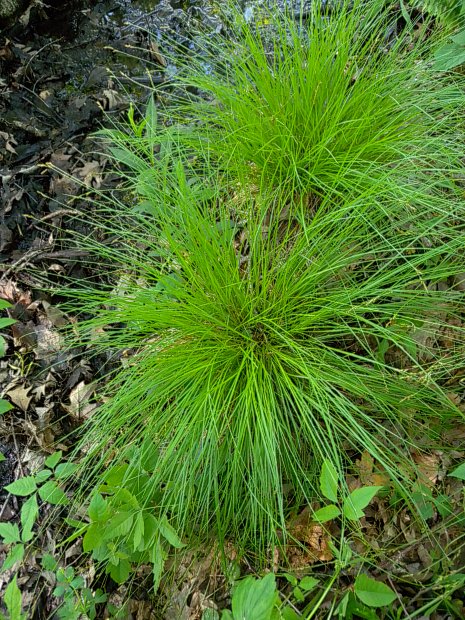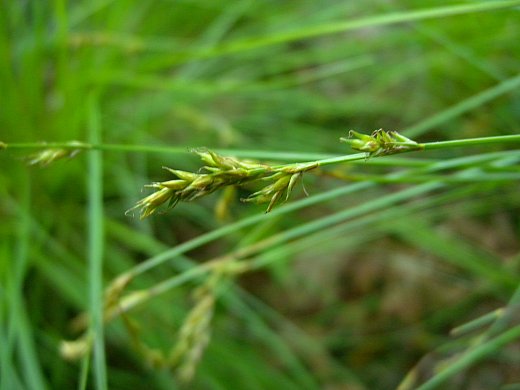
The perigynia of the pistillate florets are 3.5-5.0 mm. in length and 1-1.25 mm. across; they are narrowly lanceoloid in shape and plano-convex, tapering gradually to a narrow beak. Their lateral margins are rounded, rather than narrowly winged, while their bases are somewhat spongy and thickened. There are several longitudinal veins on both the inner and outer sides of each perigynium. The exterior surface of each perigynium is light green and glabrous, although it becomes whitened toward the base. The pistillate scales are 2.5-4.0 mm. long and lanceolate in shape with membranous margins. Each female floret consists of an ovary with a pair of stigmata at its apex. The blooming period occurs from mid- to late spring. The florets are cross-pollinated by the wind. During the summer, the spikelets change from light green to light tan. The achenes and their perigynia can float on water or be blown about by the wind. Individual achenes are about 2.0 mm. long and 0.75-1.0 mm. across. The root system is short-rhizomatous and fibrous.
Cultivation: The preference is partial sun to light shade, wet to consistently moist conditions, and mucky or sandy-mucky soil containing some decaying leaf litter. Shallow standing water is tolerated.

Range & Habitat: The native Brome-Like Sedge is found primarily in NE Illinois and a few scattered counties elsewhere within the state (see Distribution Map). It is uncommon. Habitats include soggy deciduous woodlands, muddy margins and shallow water of vernal pools in wooded areas, hardwood swamps, typical seeps and gravelly seeps in wooded areas, bogs, edges of marshes, and sedge meadows. Sometimes these habitats are sandy. This sedge is found in higher quality natural areas.
Faunal Associations: The caterpillars of the butterfly, Satyrodes eurydice (Eyed Brown), and the caterpillars of several skippers feed on wetland Carex spp. (sedges): Euphyes conspicuus (Black Dash), Euphyes dion (Dion Skipper), Poanes massasoit (Mulberry Wing), and Poanes viator (Broad-Winged Skipper). Moth caterpillars that feed on sedges include Apamea indocilis (Ignorant Apamea), Chortodes inquinata (Tufted Sedge Moth), Ctenucha virginica (Virginia Ctenucha), Macrochilo absorptalis (Slant-Lined Owlet), Meropleon diversicolor (Multicolored Sedge Miner), Monroessa icciusalis (Pondside Pyralid Moth), and Simyra henrici (Henry's Marsh Moth). Other insect feeders include many aphids (see Aphid Table); several leafhoppers (mostly Cosmotettix spp.); the plant bugs Mimoceps insignis, Teratocoris discolor, and Teratocoris paludum; the seed bugs Cymus angustatus and Oedancala dorsalis; several semi-aquatic leaf beetles (mostly Plateumaris spp.); stem-boring larvae of Chlorops certima (Chloropid Fly sp.), Cordilura varipes (Scathophagid Fly sp.), and Loxocera cylindrica (Rust Fly); and several sedge grasshoppers (Stethophyma spp.). Among birds, the seedheads are consumed by the Wood Duck, Mallard, Black Duck, Ruffed Grouse (immature birds), Woodcock, and various granivorous songbirds. Among mammals, the Muskrat occasionally feeds on the roots, culms, and young sprouts of sedges, while the Fox Squirrel and Gray Squirrel consume the seeds to a minor extent.

Photographic Location: Along the edge of a vernal pool in a sandy woodland at the Indiana Dunes State Park in NW Indiana.
Comments: This delicate sedge looks like a smaller version of the better-known Carex stricta (Tussock Sedge), although it is not closely related to the latter species. It has a grassy appearance, superficially resembling one of the Brome grasses (Bromus spp.) or perhaps another grass. However, unlike a Brome grass, it forms dense tussocks. In Illinois, the closest relative of Brome-Like Sedge is Carex deweyana (Dewey's Sedge); this latter species has been found only once within the state. Dewey's Sedge differs by having wider leaf blades (exceeding 3 mm. across), wider perigynia that lack significant veins along their inner sides, and spikelets that are less likely to overlap with each other along the rachis (central stalk) of the inflorescence.